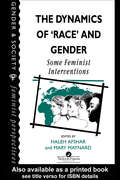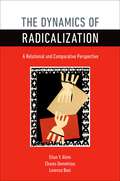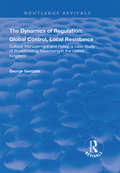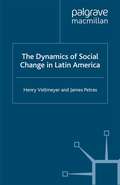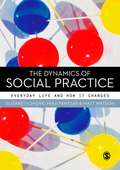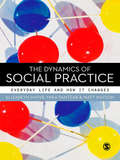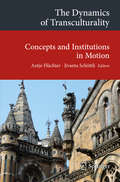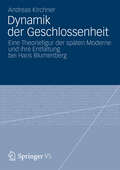- Table View
- List View
Dynamics of National Identity: Media and Societal Factors of What We Are (Routledge Advances in Sociology)
by Leonie Huddy Peter Schmidt Jürgen Grimm Josef SeethalerGlobalization, immigration and economic crisis challenge the conceptions of nations, trans-national institutions and post-ethnic societies which are central topics in social sciences' discourses. This book examines in an interdisciplinary and international comparative way structures of national identity which are in conflict with or supporting multi-ethnic diversity and trans-national connectivity. The book’s first section seeks to clarify the concepts of national identity, nationalism, patriotism and cosmopolitism and to operationalize them consistently. The next section regards the diversity within national states and the consequences for the management of identity and intra-national integration. The third section focuses on external integration between different nations by searching for the "squaring of the circle" between the bonding with co-patriots and the critical reflection of one's own national perspective in relation to others. The last section explores to what extent and in which ways media use shapes collective identity.
The Dynamics of Opportunity in America: Evidence and Perspectives
by Irwin Kirsch Henry BraunAcross the country, our children are beginning life from very different starting points. Some have aspirations and believe they can be achieved. For too many others, aspirations are tempered, if not dashed, by the sobering realities of everyday life. These different starting points place children on distinctly different trajectories of growth and development, ultimately leading to vastly different adult outcomes. How did we get to a place where circumstances of birth have become so determinative? And what must we do, within communities and across our country, to better equalize opportunity for more Americans – both young and old? The editors of this volume contend that if, as a nation, we do nothing, then we will continue to drift apart, placing an unsustainable strain on the nation’s social fabric and the character of its democracy. Consequently, understanding the dynamics governing the distribution and transmission of opportunity – and transforming this understanding into policies and programs – is critical for not only the life outcomes of individual Americans and their children, but also the country as a whole. The goal of Educational Testing Service’s Opportunity in America initiative is to explore these powerful dynamics and to describe and convey them in a way that advances the national conversation about why we must take action – and how best to do so. This volume contains 14 chapters, including an epilogue, written by leaders from a range of fields including education, economics, demography, and political science. Collectively, they not only illuminate key aspects of the problem but also offer suggestions of what policies, programs, and changes in practices could begin to reverse the trends we are seeing. Written in an engaging style, this volume constitutes an essential foundation for informed discussion and strategic analysis.
Dynamics of Organizational Change and Learning (Wiley Handbooks in Work & Organizational Psychology)
by Jaap BoonstraThis handbook focuses on the complex processes and problems oforganizational change and relates current knowledge of individualand group psychology to the understanding of the dynamics ofchange. * Complementary and competing insights are presented as overviewsof theory and research * Offers helpful insights about choosing models and methods inspecific situations * Chapters by international authors of the highest quality
Dynamics of Organizational Populations: Density, Legitimation, and Competition
by Glenn R. Carroll Michael T. HannanWhy does the number of organizations of any given kind vary over time? Utilizing a diverse group of organizations including national labor unions, newspapers and newspaper publishers, brewing firms, life insurance companies, and banks, this book seeks to deepen and broaden the understanding of change in organizational populations by examining the dynamics of numbers of organizations in populations. Such an approach involves explaining the sources of growth and decline in the sum of organizations (what the authors call "density") over the histories of populations of organizations. The authors conclude their study by formulating a theory of density-dependent legitimation and competition.
The Dynamics of Persuasion: Communication and Attitudes in the Twenty-First Century (Routledge Communication Series)
by Richard M. PerloffThe Dynamics of Persuasion has been a staple resource for teaching persuasion for nearly two decades. Author Richard M. Perloff speaks to students in a style that is engaging and informational, explaining key theories and research as well as providing timely and relevant examples. The companion website includes materials for both students and instructors, expanding the pedagogical utilities and facilitating adoptions. The sixth edition includes: updated theoretical and applied research in a variety of areas, including framing, inoculation, and self-affirmation; new studies of health campaigns; expanded coverage of social media marketing; enhanced discussion of the Elaboration Likelihood Model in light of continued research and new applications to everyday persuasion. The fundamentals of the book – emphasis on theory, clear-cut explanation of findings, in-depth discussion of persuasion processes and effects, and easy-to-follow real-world applications – continue in the sixth edition.
The Dynamics of Persuasion: Communication and Attitudes in the Twenty-First Century (Routledge Communication Series)
by Richard M. PerloffNow in its seventh edition, this essential text continues to provide students with a comprehensive yet accessible overview of the study and practice of persuasive communication. Attuned to the swift changes in the world of persuasion in the twenty-first century, this book covers how theories and research illuminate and adapt to our present digital era, with continued attention to ethical implications and today’s big topics. This new edition features updated definitions of key terms in the field as they relate to present-day practice; an integration of persuasion theories and the ubiquity of online influence; new examples and cases to illustrate persuasive communication’s approach to health campaigns, attitudes, communicator appeals, dissonance, and ethics; and a thorough reflection of the most current scholarship in the field. The Dynamics of Persuasion, Seventh Edition provides a solid foundation for undergraduate students in communication studies and psychology to grasp the key concepts and practices of persuasive communication today. The book is complimented by online resources for both instructors and students, including an instructor’s manual, lecture slides, sample test questions, and links to relevant articles and videos illustrating concepts presented in the text. Please visit www.routledge.com/cw/perloff.
The Dynamics of Persuasion: Communication and Attitudes in the Twenty-First Century (Routledge Communication Series)
by Richard M. PerloffNow in its seventh edition, this essential text continues to provide students with a comprehensive yet accessible overview of the study and practice of persuasive communication. Attuned to the swift changes in the world of persuasion in the twenty-first century, this book covers how theories and research illuminate and adapt to our present digital era, with continued attention to ethical implications and today’s big topics. This new edition features updated definitions of key terms in the field as they relate to present-day practice; an integration of persuasion theories and the ubiquity of online influence; new examples and cases to illustrate persuasive communication’s approach to health campaigns, attitudes, communicator appeals, dissonance, and ethics; and a thorough reflection of the most current scholarship in the field. The Dynamics of Persuasion, Seventh Edition provides a solid foundation for undergraduate students in communication studies and psychology to grasp the key concepts and practices of persuasive communication today. The book is complimented by online resources for both instructors and students, including an instructor’s manual, lecture slides, sample test questions, and links to relevant articles and videos illustrating concepts presented in the text. Please visit www.routledge.com/cw/perloff.
The Dynamics of Persuasion: Communication and Attitudes in the Twenty-First Century (Routledge Communication Series)
by Richard M. PerloffThe Dynamics of Persuasion has been a staple resource for teaching persuasion for nearly two decades. Author Richard M. Perloff speaks to students in a style that is engaging and informational, explaining key theories and research as well as providing timely and relevant examples. The companion website includes materials for both students and instructors, expanding the pedagogical utilities and facilitating adoptions. The sixth edition includes: updated theoretical and applied research in a variety of areas, including framing, inoculation, and self-affirmation; new studies of health campaigns; expanded coverage of social media marketing; enhanced discussion of the Elaboration Likelihood Model in light of continued research and new applications to everyday persuasion. The fundamentals of the book – emphasis on theory, clear-cut explanation of findings, in-depth discussion of persuasion processes and effects, and easy-to-follow real-world applications – continue in the sixth edition.
The Dynamics of Persuasion: Communication and Attitudes in the 21st Century (Routledge Communication Series)
by Richard M. PerloffThe eighth edition of The Dynamics of Persuasion again guides readers in understanding the power and limits of persuasion in contemporary society. This edition continues its accessible and detailed illustration of the theoretical underpinnings of persuasive communication through contemporary and relevant examples of persuasion in action. It features coverage of new scholarship on misinformation, health communication, and persuasion effects, including careful attention to persuasion’s role in the Covid-19 pandemic. Important issues such as racial injustice, climate change, and barriers to persuading the politically and psychologically polarized also receive a fresh examination. The book brings together classic terms and approaches from earlier editions with new global developments to help readers adopt a more thoughtful perspective on persuasion. The eighth edition is an essential resource for courses in persuasion at the undergraduate and graduate levels within communication studies, psychology, and business programs. Online resources also accompany the text: an Instructor Manual that contains sample syllabi, key terms, chapter outlines, sample discussion questions, and links to relevant news articles and other online resources such as videos; Lecture Slides; and a Testbank. Please visit: www.routledge.com/9781032268187.
The Dynamics of Persuasion: Communication and Attitudes in the 21st Century (Routledge Communication Series)
by Richard M. PerloffThe eighth edition of The Dynamics of Persuasion again guides readers in understanding the power and limits of persuasion in contemporary society. This edition continues its accessible and detailed illustration of the theoretical underpinnings of persuasive communication through contemporary and relevant examples of persuasion in action. It features coverage of new scholarship on misinformation, health communication, and persuasion effects, including careful attention to persuasion’s role in the Covid-19 pandemic. Important issues such as racial injustice, climate change, and barriers to persuading the politically and psychologically polarized also receive a fresh examination. The book brings together classic terms and approaches from earlier editions with new global developments to help readers adopt a more thoughtful perspective on persuasion. The eighth edition is an essential resource for courses in persuasion at the undergraduate and graduate levels within communication studies, psychology, and business programs. Online resources also accompany the text: an Instructor Manual that contains sample syllabi, key terms, chapter outlines, sample discussion questions, and links to relevant news articles and other online resources such as videos; Lecture Slides; and a Testbank. Please visit: www.routledge.com/9781032268187.
The Dynamics of Pilgrimage: Christianity, Holy Places, and Sensory Experience (Routledge Studies in Pilgrimage, Religious Travel and Tourism)
by Dee DyasThis book offers a systematic, chronological analysis of the role played by the human senses in experiencing pilgrimage and sacred places, past and present. It thus addresses two major gaps in the existing literature, by providing a broad historical narrative against which patterns of continuity and change can be more meaningfully discussed, and focusing on the central, but curiously neglected, area of the core dynamics of pilgrim experience. Bringing together the still-developing fields of Pilgrimage Studies and Sensory Studies in a historically framed conversation, this interdisciplinary study traces the dynamics of pilgrimage and engagement with holy places from the beginnings of the Judaeo-Christian tradition to the resurgence of interest evident in twenty-first century England. Perspectives from a wide range of disciplines, from history to neuroscience, are used to examine themes including sacred sites in the Bible and Early Church; pilgrimage and holy places in early and later medieval England; the impact of the English Reformation; revival of pilgrimage and sacred places during the nineteenth and twentieth Centuries; and the emergence of modern place-centred, popular 'spirituality'. Addressing the resurgence of pilgrimage and its persistent link to the attachment of meaning to place, this book will be a key reference for scholars of Pilgrimage Studies, History of Religion, Religious Studies, Sensory Studies, Medieval Studies, and Early Modern Studies.
The Dynamics of Pilgrimage: Christianity, Holy Places, and Sensory Experience (Routledge Studies in Pilgrimage, Religious Travel and Tourism)
by Dee DyasThis book offers a systematic, chronological analysis of the role played by the human senses in experiencing pilgrimage and sacred places, past and present. It thus addresses two major gaps in the existing literature, by providing a broad historical narrative against which patterns of continuity and change can be more meaningfully discussed, and focusing on the central, but curiously neglected, area of the core dynamics of pilgrim experience. Bringing together the still-developing fields of Pilgrimage Studies and Sensory Studies in a historically framed conversation, this interdisciplinary study traces the dynamics of pilgrimage and engagement with holy places from the beginnings of the Judaeo-Christian tradition to the resurgence of interest evident in twenty-first century England. Perspectives from a wide range of disciplines, from history to neuroscience, are used to examine themes including sacred sites in the Bible and Early Church; pilgrimage and holy places in early and later medieval England; the impact of the English Reformation; revival of pilgrimage and sacred places during the nineteenth and twentieth Centuries; and the emergence of modern place-centred, popular 'spirituality'. Addressing the resurgence of pilgrimage and its persistent link to the attachment of meaning to place, this book will be a key reference for scholars of Pilgrimage Studies, History of Religion, Religious Studies, Sensory Studies, Medieval Studies, and Early Modern Studies.
Dynamics of Poverty in Rural Bangladesh
by Pk. Md. Rahman Noriatsu Matsui Yukio IkemotoThe study of poverty dynamics is important for effective poverty alleviation policies because the changes in income poverty are also accompanied by changes in socioeconomic factors such as literacy, gender parity in school, health care, infant mortality, and asset holdings. In order to examine the dynamics of poverty, information from 1,212 households in 32 rural villages in Bangladesh was collected in December 2004 and December 2009. This book reports the analytical results from quantitative and qualitative surveys from the same households at two points of time, which yielded the panel data for understanding the changes in situations of poverty.Efforts have been made to include the most recent research from diverse disciplines including economics, statistics, anthropology, education, health care, and vulnerability study. Specifically, findings from logistic regression analysis, polychoric principal component analysis, kernel density function, income mobility with the help of the Markov chain model, and child nutrition status from anthropometric measures have been presented.Asset holdings and liabilities of the chronically poor as well as those of three other economic groups (the descending non-poor, the ascending poor, and the non-poor) are analyzed statistically. The degrees of vulnerability to poverty are examined by years of schooling, landholding size, gender of household head, social capital, and occupation. The multiple logistic regression model was used to identify important risk factors for a household’s vulnerability.In 2009, some of the basic characteristics of the chronically poor were: higher percentage and number of female-headed households, higher dependency ratio, lower levels of education, fewer years of schooling, and limited employment. There was a low degree of mobility of households from one poverty status to another in the period 2004-2009, implying that the process of economic development and high economic growth in the macroeconomy during this time failed to improve the poverty situation in rural Bangladesh.
The Dynamics Of Race And Gender: Some Feminist Interventions
by Haleh Afshar Mary MaynardDuring the past decade, feminism and women's studies have been forced to acknowledge the diversities of women's experiences, as well as the patriarchal oppression that they share. The emphasis on difference has shattered the illusion of homogeneity and sisterhood which previously characterized white, middle-class Westernized feminist politics and analysis.; There is relatively little work which concentrates on the inter-relationships of race and gender in general, and the consequences of racism, for women of different backgrounds, in particular. "The Dynamics of Race and Gender" aims to contribute to the debate and understanding in this area. Emphasis has been given to age, class, disability, race and sexuality. The contributors to this volume are from different religious, cultural and ethnic backgrounds, giving a balanced and broad ranging perspective on this important social question.; Organized around three main themes, which are; issues of theory and method, questions of identity, racism and sexism at work, the chapters of this book indicate how the processes of race and gender interrelate in highly complex and contradictory ways. Demonstrating the benefits to be gained from analysing the interplay of various axes of differentiation in specific empirical and historical locations, and in doing so, under- scoring the point that diversity among women cannot be seen as a static phenomenon.
The Dynamics Of Race And Gender: Some Feminist Interventions (Gender And Society Ser.)
by Haleh Afshar Mary MaynardDuring the past decade, feminism and women's studies have been forced to acknowledge the diversities of women's experiences, as well as the patriarchal oppression that they share. The emphasis on difference has shattered the illusion of homogeneity and sisterhood which previously characterized white, middle-class Westernized feminist politics and analysis.; There is relatively little work which concentrates on the inter-relationships of race and gender in general, and the consequences of racism, for women of different backgrounds, in particular. "The Dynamics of Race and Gender" aims to contribute to the debate and understanding in this area. Emphasis has been given to age, class, disability, race and sexuality. The contributors to this volume are from different religious, cultural and ethnic backgrounds, giving a balanced and broad ranging perspective on this important social question.; Organized around three main themes, which are; issues of theory and method, questions of identity, racism and sexism at work, the chapters of this book indicate how the processes of race and gender interrelate in highly complex and contradictory ways. Demonstrating the benefits to be gained from analysing the interplay of various axes of differentiation in specific empirical and historical locations, and in doing so, under- scoring the point that diversity among women cannot be seen as a static phenomenon.
The Dynamics of Radicalization: A Relational and Comparative Perspective
by Lorenzo Bosi Chares Demetriou Eitan Y. AlimiWhy is it that some social movements engaged in contentious politics experience radicalization whereas others do not? The Dynamics of Radicalization offers an innovative reply by investigating how and when social movement organizations switch from a nonviolent mode of contention to a violent one. Moving beyond existing explanations that posit aggressive motivations, grievances or violence-prone ideologies, this book demonstrates how these factors gain and lose salience in the context of relational dynamics among various parties and actors involved in episodes of contention. Drawing on a comparative historical analysis of al-Qaeda, the Red Brigades, the Cypriot EOKA, the authors develop a relational, mechanism-based theory that advances our understanding of political violence in several important ways by identifying turning points in the radicalization process, similar mechanisms at work across each case, and the factors that drive or impede radicalization. The Dynamics of Radicalization offers a counterpoint to mainstream works on political violence, which often presume that political violence and terrorism is rooted in qualities intrinsic to or developed by groups considered to be radical.
The Dynamics of Radicalization: A Relational and Comparative Perspective
by Lorenzo Bosi Chares Demetriou Eitan Y. AlimiWhy is it that some social movements engaged in contentious politics experience radicalization whereas others do not? The Dynamics of Radicalization offers an innovative reply by investigating how and when social movement organizations switch from a nonviolent mode of contention to a violent one. Moving beyond existing explanations that posit aggressive motivations, grievances or violence-prone ideologies, this book demonstrates how these factors gain and lose salience in the context of relational dynamics among various parties and actors involved in episodes of contention. Drawing on a comparative historical analysis of al-Qaeda, the Red Brigades, the Cypriot EOKA, the authors develop a relational, mechanism-based theory that advances our understanding of political violence in several important ways by identifying turning points in the radicalization process, similar mechanisms at work across each case, and the factors that drive or impede radicalization. The Dynamics of Radicalization offers a counterpoint to mainstream works on political violence, which often presume that political violence and terrorism is rooted in qualities intrinsic to or developed by groups considered to be radical.
The Dynamics of Regulation: Cultural Management and Policy: a case study of broadcasting advertising in the United Kingdom
by George GantziasThis title was first published in 2001. New technologies and the liberalization of the broadcasting and telecommunications market, together with the digitalization and globalization of new services, have challenged irrevocably not only the traditional markets and instructional structures but also the legal systems of broadcasting and telecommunication sectors in the 21st century. This text takes into account changes in digital broadcasting and telecommunication by pointing out that convergence is the process through which broadcasting, telecommunication, press and information sectors are transformed into new sectors (info-com arteries, info-com products, info-com services and info-com content) in order to be fully compatible with the emerging new info-communication industry in the digital transformation and info-communication era.
The Dynamics of Regulation: Cultural Management and Policy: a case study of broadcasting advertising in the United Kingdom
by George GantziasThis title was first published in 2001. New technologies and the liberalization of the broadcasting and telecommunications market, together with the digitalization and globalization of new services, have challenged irrevocably not only the traditional markets and instructional structures but also the legal systems of broadcasting and telecommunication sectors in the 21st century. This text takes into account changes in digital broadcasting and telecommunication by pointing out that convergence is the process through which broadcasting, telecommunication, press and information sectors are transformed into new sectors (info-com arteries, info-com products, info-com services and info-com content) in order to be fully compatible with the emerging new info-communication industry in the digital transformation and info-communication era.
The Dynamics of Social Change in Latin America (International Political Economy Series)
by Henry Veltmeyer J. PetrasThis study examines fundamental theoretical and conceptual issues of social change in Latin America in the context of detailed empirical analysis. It challenges the major assumptions and propositions that underlie globalization theory, reworking and fine tuning the concepts of imperialism and social class as relevant to understanding the 'new world order'. The study centers on the structural features of Latin America and the state policies reconcentrating power in the capitalist class at the expense of labor. The study surveys the contradictory tendencies of concentrated wealth and power and the emergence of new socio-political movements and alternative development strategies to the dominant paradigm.
The Dynamics of Social Practice: Everyday Life and how it Changes
by Dr Elizabeth Shove Dr Matt Watson Mika PantzarEveryday life is defined and characterised by the rise, transformation and fall of social practices. Using terminology that is both accessible and sophisticated, this essential book guides the reader through a multi-level analysis of this dynamic. In working through core propositions about social practices and how they change the book is clear and accessible; real world examples, including the history of car driving, the emergence of frozen food, and the fate of hula hooping, bring abstract concepts to life and firmly ground them in empirical case-studies and new research. Demonstrating the relevance of social theory for public policy problems, the authors show that the everyday is the basis of social transformation addressing questions such as: how do practices emerge, exist and die? what are the elements from which practices are made? how do practices recruit practitioners? how are elements, practices and the links between them generated, renewed and reproduced? Precise, relevant and persuasive this book will inspire students and researchers from across the social sciences. Elizabeth Shove is Professor of Sociology at Lancaster University. Mika Pantzar is Research Professor at the National Consumer Research Centre, Helsinki. Matt Watson is Lecturer in Social and Cultural Geography at University of Sheffield.
The Dynamics of Social Practice: Everyday Life and how it Changes
by Dr Elizabeth Shove Dr Matt Watson Mika PantzarEveryday life is defined and characterised by the rise, transformation and fall of social practices. Using terminology that is both accessible and sophisticated, this essential book guides the reader through a multi-level analysis of this dynamic. In working through core propositions about social practices and how they change the book is clear and accessible; real world examples, including the history of car driving, the emergence of frozen food, and the fate of hula hooping, bring abstract concepts to life and firmly ground them in empirical case-studies and new research. Demonstrating the relevance of social theory for public policy problems, the authors show that the everyday is the basis of social transformation addressing questions such as: how do practices emerge, exist and die? what are the elements from which practices are made? how do practices recruit practitioners? how are elements, practices and the links between them generated, renewed and reproduced? Precise, relevant and persuasive this book will inspire students and researchers from across the social sciences. Elizabeth Shove is Professor of Sociology at Lancaster University. Mika Pantzar is Research Professor at the National Consumer Research Centre, Helsinki. Matt Watson is Lecturer in Social and Cultural Geography at University of Sheffield.
Dynamics of the Cold War in Asia: Ideology, Identity, and Culture
by T. Vu W. WongsurawatThis book focuses on the neglected cultural front of the Cold War in Asia to explore the mindsets of Asian actors and untangle the complex cultural alliances that undergirded the security blocs on this continent.
The Dynamics of Transculturality: Concepts and Institutions in Motion (Transcultural Research – Heidelberg Studies on Asia and Europe in a Global Context)
by Antje Flüchter Jivanta SchöttliThe purpose of this volume is to identify and analyze the mechanisms and processes through which concepts and institutions of transcultural phenomena gain and are given momentum. Applied to a range of cases, including examples drawn from ancient Greece and modern India, the early modern Portuguese presence in China and politics of elite-mass dynamics in the People’s Republic of China, the book provides a template for the study of transcultural dynamics over time. Besides the epochal range, the papers in this volume illustrate the thematic diversity assembled under the umbrella of the Heidelberg Cluster of Excellence “Asia and Europe in a Global Context.” Drawing from both the humanities and social sciences, stretching across several world areas and centuries, the book is an interdisciplinary work, aptly reflected in the collaboration of its editors: a historian and political scientist.
Dynamik der Geschlossenheit: Eine Theoriefigur der späten Moderne und ihre Entfaltung bei Hans Blumenberg
by Andreas KirchnerDass sich jegliches Geschehen der operativ geschlossenen Verknüpfung von Ereignissen verdankt, ist sicherlich die theorieästhetische Provokation der Moderne. Die Dynamik der Geschlossenheit wird als eine Theoriefigur ins Spiel gebracht, welche die sich seit der Neuzeit entwickelnde Idee der Selbstbezüglichkeit radikalisiert und jegliche Beobachtung von einem Absoluten entlastet. Aus der theorieästhetischen Perspektive wird auch die kultur-phänomenologische Anthropologie Hans Blumenbergs unter dem Signum der operativen Geschlossenheit entfaltet. Indem mit Niklas Luhmann und Hans Blumenberg zwei Perspektiven ins Gespräch gebracht werden, die man sonst nicht in einem Atemzug nennt, kann letztlich Blumenberg in einer innovativen Lesart nicht nur als Denker der Neuzeit, sondern auch als Beobachter der späten Moderne verstanden werden.









